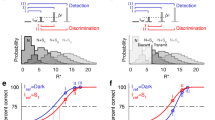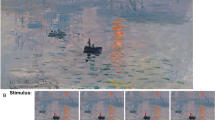Abstract
VERY few photons need to be captured by the receptors of the human eye to excite a sensation of light. The number required is certainly no greater than 100 and may be much less1,2. A single rod requires only one photon to signal light3. A question which therefore arises is why do we not see punctate photon absorptions when we look at a very dim patch of light? The retina catches incident photons only sporadically in time, and therefore in space, when a source is very dim. If very few photons are sufficient to detect light, it might be expected that we should see isolated flashes of light, so that a patch of light appears mottled or speckled. Indeed, if a dim object is viewed on the screen of a cascaded image intensifier, so that each quantum caught by the cathode is amplified, we do see quanta as individual flashes or specks on the display phosphor2. This apparent contradiction creates a physiological problem ignored in most standard textbooks on vision although the issue has been raised4,5. We report here a possible solution; we have observed point sources of light set up one at a time very rapidly and at random by computer within a square patch on the face of an oscilloscope and find that as the luminance of the point sources is decreased the number of specks seen increases markedly, and that the appearance of motion, due presumably in the first place to the effect of the chance sequences of specks on motion-sensitive neurones, becomes weaker. We propose that at or near the threshold, the number of specks seen increases to infinity so that the specks crowd together to appear uniform and so the motion ceases.
This is a preview of subscription content, access via your institution
Access options
Subscribe to this journal
Receive 51 print issues and online access
$199.00 per year
only $3.90 per issue
Buy this article
- Purchase on Springer Link
- Instant access to full article PDF
Prices may be subject to local taxes which are calculated during checkout
Similar content being viewed by others
References
Hecht, S., Shlaer, S. & Pirenne, M. H. J. gen. Physiol. 25, 819–840 (1942).
Van Meeteren, A. Visual Aspects of Image Intensification (Bronder, Rotterdam, 1973).
Pirenne, M. H. & Denton, E. J. Nature 170, 1039–1042 (1952).
Rose, A. Vision, Human and Electronic (Plenum, New York, 1973).
De Vries, H. Physica 10, 553–564 (1943).
Barlow, H. B., Fitzhugh, R. & Kuffler, S. W. J. Physiol., Lond. 137, 338–354 (1957).
Braddick, O., Campbell, F. W. & Atkinson, J. Handbook of Sensory Physiology, Vol. 8 (eds Held, R., Leibowitz, H. & Teuber, H. L.) (Springer, Heidelberg, 1977).
Hubel, D. H. & Wiesel, T. N. Proc. R. Soc. Lond. 198, 1–59 (1977).
Andrews, D. P. Nature 205, 1218–1220 (1965).
Author information
Authors and Affiliations
Rights and permissions
About this article
Cite this article
ROSS, J., CAMPBELL, F. Why do we not perceive photons?. Nature 275, 541–542 (1978). https://doi.org/10.1038/275541a0
Received:
Accepted:
Issue Date:
DOI: https://doi.org/10.1038/275541a0
Comments
By submitting a comment you agree to abide by our Terms and Community Guidelines. If you find something abusive or that does not comply with our terms or guidelines please flag it as inappropriate.



